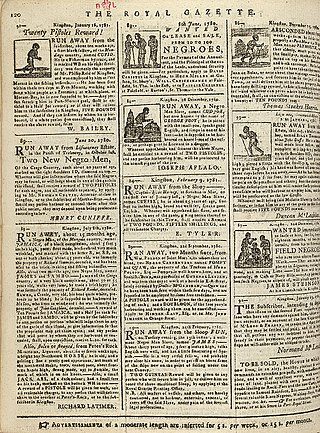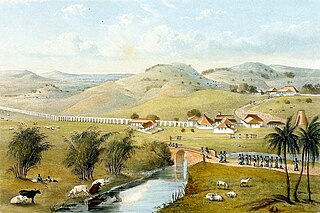Related Research Articles

Saint Ann is the largest parish in Jamaica. It is situated on the north coast of the island, in the county of Middlesex, roughly halfway between the eastern and western ends of the island. It is often called "the Garden Parish of Jamaica" on account of its natural floral beauty. Its capital is Saint Ann's Bay. Saint Ann comprises New Seville, the first Spanish settlement in Jamaica.

The parishes of Jamaica are the main units of local government in Jamaica. They were created following the English Invasion of Jamaica in 1655. This administrative structure for the Colony of Jamaica developed slowly. However, since 1 May 1867, Jamaica has been divided into the current fourteen parishes. These were retained after independence in 1962. They are grouped into three historic counties, which no longer have any administrative relevance. Every parish has a coast; none are landlocked.

Saint Thomas, once known as Saint Thomas in the East, is a suburban parish situated at the south eastern end of Jamaica, within the county of Surrey. It is the birthplace of Paul Bogle, designated in 1969 as one of Jamaica's seven National Heroes. Morant Bay, its chief town and capital, is the site of the Morant Bay Rebellion in 1865, of which Bogle was a leader.

Saint Catherine is a parish in the south east of Jamaica. It is located in the county of Middlesex, and is one of the island's largest and most economically valued parishes because of its many resources. It includes the first capital of Jamaica, Spanish Town, originally known as San Jago de la Vega or Santiago de la Vega.

Westmoreland is the westernmost parish in Jamaica, located on the south side of the island. It is situated south of Hanover, southwest of Saint James, and northwest of Saint Elizabeth, in the county of Cornwall. The chief town and capital is Savanna-la-Mar. Negril, a famous tourist destination, is also situated in the parish.

Saint Andrew is a parish, situated in the southeast of Jamaica in the county of Surrey. It lies north, west and east of Kingston, and stretches into the Blue Mountains. As of the 2011 census, it had a population of 573,369, the highest of any of the parishes in Jamaica.

Tacky's Revolt was a slave rebellion in the British colony of Jamaica which lasted from 7 April 1760 to 1761. Spearheaded by self-emancipated Coromantee people, the rebels were led by a Fante royal named Tacky. It was the most significant slave rebellion in the West Indies between the 1733 slave insurrection on St. John and the 1791 Haitian Revolution. The rebels were eventually defeated after British colonial forces, assisted by Jamaican Maroons, waged a gruelling counterinsurgency campaign. According to historian Trevor Burnard, "[in] terms of its shock to the imperial system, only the American Revolution surpassed Tacky's War in the eighteenth century." It was also the largest slave rebellion in the British West Indies until the Baptist War of 1831, which also occurred in Jamaica.

Lacovia is a town in Saint Elizabeth Parish, Jamaica, located on the Black River between the Upper Morass and the Lower Morass.

Saint Ann's Bay is a settlement in Jamaica, the capital of Saint Ann Parish. It had a population of 10,961 at the 1991 census.

Alexander Aikman was a Scottish printer, newspaper publisher, planter, and member of Jamaica's House of Assembly. From 1805 to 1825, he was a member of the House of Assembly as the representative of Saint George parish.
The Receiver General of Jamaica was the public official in Jamaica responsible for receiving and disbursing money of the Government of Jamaica.
Zachary Bayly (1721-1769) was a English-born Jamaican planter and politician.
Matthew Gregory (1693-1779) was a planter in Jamaica who sat in the House of Assembly of Jamaica for Saint James Parish in 1718 and 1722. He sat for Saint Ann in 1726.
Thomas Iredell was Attorney General of Jamaica in 1766 and served on the Royal Council of Jamaica from 1775 until the date of his death.
Matthew Byndloss (1721-1765) was a member of the House of Assembly of Jamaica for Saint Ann Parish. He was killed during a slave rebellion at Whitehall plantation.

Trinity was a plantation in colonial Jamaica, located south of Port Maria, in Saint Mary Parish, one of several plantations owned by Zachary Bayly that formed part of the area known as Bayly's Vale. By the early nineteenth century, over 1,000 people were enslaved there producing mainly sugar and rum for which a mile-long aqueduct was built by Nathaniel Bayly to supply water for the refining process.

A pen was a livestock farm on the Island of Jamaica. Pen-keeping included the breeding of cattle, horses, mules, sheep and dairy farming. Gardner (1873), referring to the 1750s, stated: "The life of a tolerably successful pen-keeper was at this period, as it is now, the most enviable to be found in the colony. Cattle thrive well, and few servants are required when once a pen is well established."
Betty C. Wood was a British historian and academic, who specialised in early American history, Atlantic history, social history, and slavery in eighteenth and early nineteenth century. She was a Fellow of Girton College, Cambridge (1971–2011) and taught in the Faculty of History, University of Cambridge, rising to become Reader in American History.
References
- ↑ "The Letters of Simon Taylor of Jamaica to Chaloner Arcedekne, 1765-1775" edited by Betty Wood et al in Betty Wood & Martin Lynn (Eds.) (2002). Travel, Trade and Power in the Atlantic 1765-1884 . Camden Fifth Series Vol. 19. Miscellany XXXV. Cambridge: Cambridge University Press. pp. 1–164. ISBN 978-0-521-82312-8.